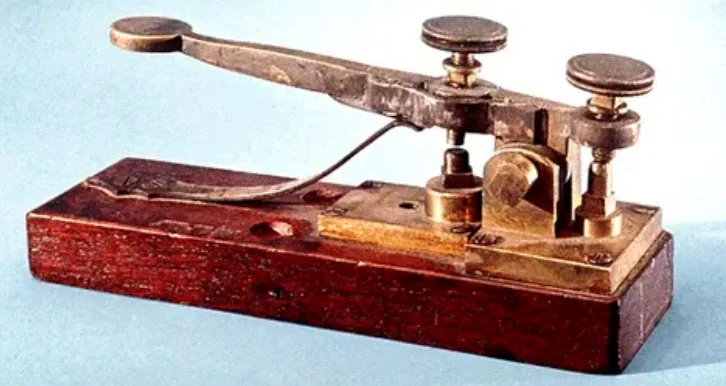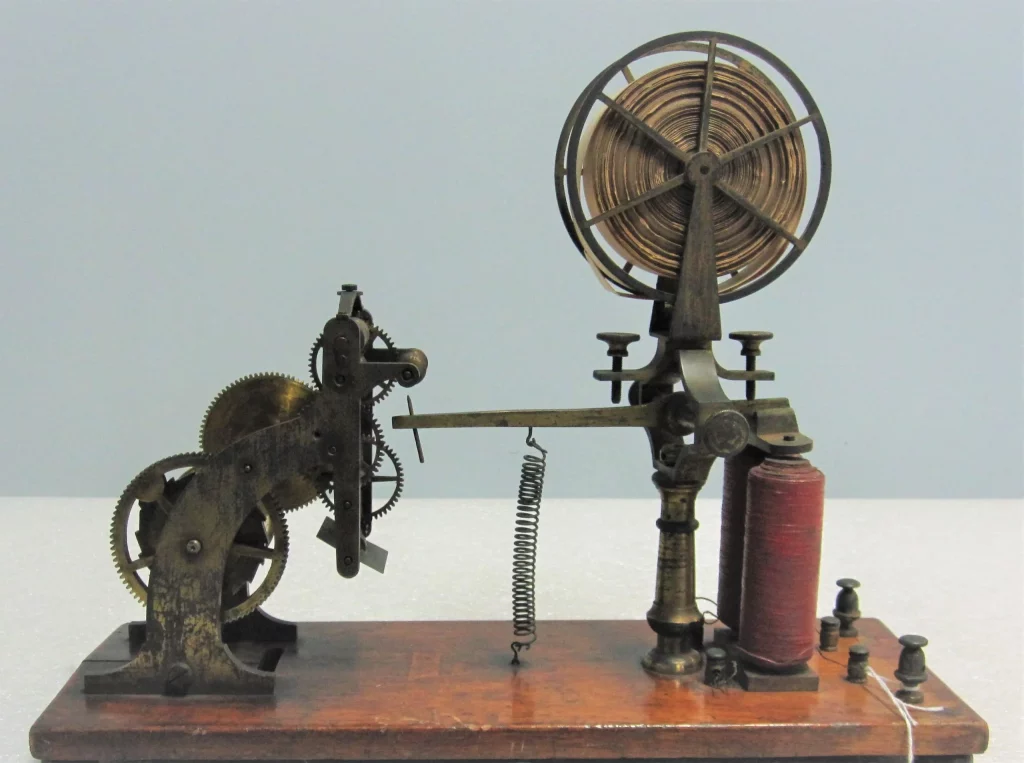Ah, the telegraph – that relic of communication history that most people now confuse with a trendy cocktail name. Remember those days when ‘LOL’ and emojis weren’t even a twinkle in the internet’s eye? Me neither, but I’ve spent an embarrassing amount of time deciphering Morse code – sometimes just to find out that all I got was a 19th-century version of a prank call.
In this delightful journey through these facts, I’ll share things that even Google might not know (or will know after this article). Ever wondered if a telegraph could order pizza? Stick around, and let’s find out together!
The telegraph wires hummed with the news all night.
Rudyard Kipling
Telegraph Facts
Let’s unravel the secrets of the past together with some fun facts about the telegraph. Remember, a quiz awaits at the end of this page, so read carefully to claim the title of communication king.
- The first telegraph message was sent by Samuel Morse on May 24, 1844.
- Morse code, a series of dots and dashes, was developed specifically for telegraph communication.
- The first transatlantic telegraph cable was completed in 1866, revolutionizing international communication.
- Telegraph systems initially used electromagnetic telegraphs, which involved complex systems of electrical circuits.
- The invention of the telegraph dramatically reduced the time it took to send messages over long distances.
- Western Union, founded in 1851, became one of the largest telegraph companies in the United States.
- The decline of the telegraph began with the advent of telephone technology.
- Telegraphy was essential for military and naval communications before the advent of radio.
- Stock tickers, a form of telegraph, were crucial for financial transactions in the late 19th and early 20th centuries.
- The first telegraphs used visual signals, like semaphores and flags, before the electrical telegraph.
- Telegraph messages were charged by the word, encouraging concise communication.
- The Pony Express, a fast mail service, was superseded by the telegraph.
- International telegraph networks facilitated global communication and trade in the 19th century.

- Early telegraph lines were often plagued by technical issues and environmental challenges.
- Telegraph operators, or telegraphists, were skilled in Morse code and played a key role in communication.
- The telegraph was instrumental in reporting news and events quickly across distances.
- Submarine telegraph cables connected continents and were engineering marvels of their time.
- Private telegraph networks were established by businesses for internal communication.
- The Railroad telegraph system was crucial for coordinating train movements and schedules.
- Thomas Edison worked as a telegraph operator and invented several improvements to telegraph technology.
- The sounder, a device that converted electrical signals into audible sounds, was a key component in telegraphy.
- During wartime, telegraphs were used for strategic military communications and intelligence.
- The telegraph was a precursor to modern digital communication technologies.
- Wireless telegraphy, or early radio communication, evolved from traditional telegraph technology.
- Telegraph poles and wires became a common sight in the 19th and early 20th centuries.
- The repeatability and reliability of telegraph messages made them a preferred medium for business communication.
- The Commercial Cable Company was a major competitor to Western Union in the late 19th century.
- Telegraph companies often had exclusive rights to report news, influencing the media and journalism.

- Telegraphy played a critical role in disaster response and emergency communication.
- The overhead telegraph lines were vulnerable to weather conditions and required regular maintenance.
- The efficiency of the telegraph revolutionized the pace of business and commerce.
- Telegraph messages were sometimes encrypted for security and privacy.
- Automatic telegraphy systems were developed to increase the speed of sending messages.
- The harmonic telegraph was an early experiment that led to the invention of the telephone.
- The first transcontinental telegraph line in the U.S. was completed in 1861.
- News agencies like Reuters started as telegraph companies, disseminating news rapidly across countries.
- Telegraph lines were often laid alongside railroad tracks, making railroads partners in telegraph development.
- The invention of the teletypewriter in the early 20th century modernized telegraph technology.
- Telegraphy was used in banking and financial transactions, including the transfer of funds.

- The diplomatic telegraph was crucial for international relations and government communications.
- Telegraphese was a concise style of writing developed to reduce the cost of telegraph transmissions.
- Some Native American tribes used telegraph lines to communicate during the 19th century.
- The decline of the telegraph began in the 1930s with the rise of telephone and radio technologies.
- The Great Eastern, a ship, played a pivotal role in laying the first successful transatlantic cable.
- Telegraph operators were sometimes involved in espionage and intelligence gathering.
- Telegraph companies employed a large workforce, including linemen, operators, and engineers.
- The last commercial Morse code telegraph message was sent in the United States in 2013.
- Phototelegraphy, sending images via telegraph, was an early form of facsimile (fax) transmission.
- The language of Morse code is still used in some areas of radio communication.
- Telegraphy influenced the development of early computers and digital communication.
Telegraph Myths

We’ve navigated the sea of telegraph facts; now let’s embark on a quest to debunk the myths and confirm the truths surrounding this iconic invention.
- Telegraphs Were Primarily Used for Personal Communication
Business and governmental purposes predominantly used telegraphs. Personal use was less common due to the relatively high cost and complexity of sending telegrams, especially in the early days. Businesses and governments quickly recognized the telegraph’s potential for rapid information exchange. - Telegraph Messages Were Always Short and Abbreviated
While many telegrams were brief due to cost and the effort of sending long messages, not all telegraph communications were short. The length and complexity of a message depended on the sender’s willingness to pay and the importance of the information. For important news, legal matters, or in-depth business discussions, people often transmitted detailed messages. - The Telegraph Instantly Made Long-Distance Communication Easy
The introduction of the telegraph was a major breakthrough, but it didn’t immediately make long-distance communication easy. Establishing telegraph lines, especially across challenging terrains and oceans, was a significant engineering feat. - Telegraphs Became Obsolete With the Invention of the Telephone
While the telephone did eventually surpass the telegraph in popularity, telegraphs remained in use for several decades after the telephone’s invention. Telegraphs provided reliable long-distance communication and were especially useful for commercial, military, and journalistic purposes well into the 20th century. - Morse Code Was the Only Telegraphic Code Used
Although Morse code is the most famous, telegraph history features several telegraphic codes. Different countries and companies developed their own codes to suit specific needs. Morse code gained widespread adoption due to its simplicity and efficiency, but it was not the sole method of telegraphic communication.
No products found.
Telegraph FAQ

Having decoded all the myths of the telegraph, it’s now time for the most-asked questions about the topic online. Read carefully; you will soon have your knowledge tested in the upcoming quiz!
- What is a Telegraph?
The telegraph is a device that transmits messages over a wire using Morse code, a series of dots and dashes representing letters and numbers. It was an early form of long-distance communication. - When was the Telegraph Invented?
Samuel Morse developed the widely used version of the telegraph in the 1830s, with the first successful demonstration occurring in 1844. - How does a Telegraph Work?
It transmits electrical signals over a wire. The sender creates Morse code signals using a key, which someone interprets into letters and words at the receiving end. - How did the Telegraph Impact Society?
It revolutionized communication, allowing for rapid message delivery across great distances. This advancement greatly influenced commerce, news distribution, and military operations, significantly impacting societal development. - Is the Telegraph Still Used Today?
While modern communication technologies have largely replaced it, some principles of the telegraph still find use in specialized areas like maritime SOS signals and railway signaling.
Telegraph Trivia

It’s time to prove if you are a good reader or not. If you don’t answer at least one code right (I mean a question), prepare to receive all your texts in Morse code for a week!
Conclusion
As we wrap up our journey through the world of telegraphs, let’s not forget how this clunky, beeping device laid the groundwork for today’s hyper-connected world. Imagine, once upon a time, tapping out messages in Morse code was the height of technology – now we get annoyed if a text takes more than a few seconds to send!
So, next time your Wi-Fi is a bit slow, remember the telegraph operators who would’ve killed for just a bit of that bandwidth. And who knows, maybe one day we’ll look back at our smartphones the way we now view the telegraph: with a mix of nostalgia.
Final question: If you could send a telegraph message to anyone in history, who would it be and what would you say? Dot dot dash dash your thoughts in the comments.


